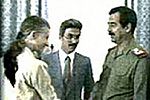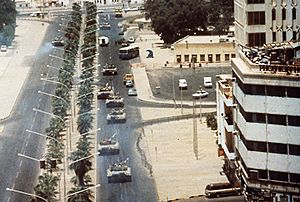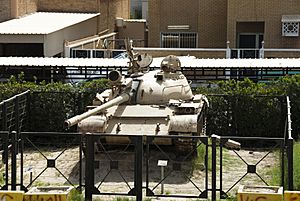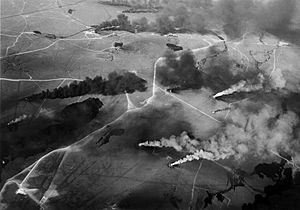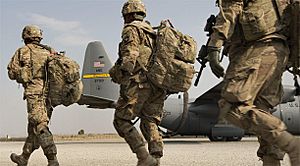Iraqi invasion of Kuwait facts for kids
Quick facts for kids Iraqi invasion of Kuwait |
|||||||||
|---|---|---|---|---|---|---|---|---|---|
| Part of the Gulf War | |||||||||
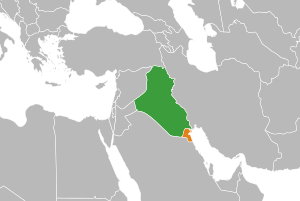 Location of Iraq (green) and Kuwait (orange) |
|||||||||
|
|||||||||
| Belligerents | |||||||||
| Commanders and leaders | |||||||||
| Strength | |||||||||
|
|
||||||||
| Casualties and losses | |||||||||
(Unconfirmed Kuwaiti claims)
(Unconfirmed Kuwaiti claims) |
|
||||||||
The Iraqi invasion of Kuwait happened on August 2, 1990. Iraq invaded its neighbor, Kuwait, leading to a seven-month military takeover of the country. This invasion and Iraq's refusal to leave Kuwait, even after the United Nations told them to, led to a big military action. A group of countries, led by the United States, stepped in.
This event became known as the first Gulf War. In the end, Iraqi troops were forced out of Kuwait. As they left, the Iraqis set fire to about 600 Kuwaiti oil wells. This was a "scorched earth" tactic, meaning they destroyed things to make it harder for the enemy.
People have different ideas about why Iraq invaded. One reason was that Iraq owed Kuwait about US$14 billion from the Iran–Iraq War and couldn't pay it back. Another reason was that Kuwait was producing a lot of oil. This kept oil prices low, which hurt Iraq's income. Iraq also accused Kuwait of stealing oil by drilling across the border.
Contents
Why Iraq Invaded Kuwait
Money Problems and Oil Disputes
When the Iran–Iraq War began, Kuwait first stayed neutral. Later, Kuwait and other Arab countries helped Iraq. Kuwait sent a lot of money to Iraq starting in 1982. Because of this help, Iran sometimes attacked Kuwaiti oil tankers and security forces. During the war, Kuwait was Iraq's main port. But after the war, their friendly relationship turned bad.
Iraq owed Kuwait US$14 billion from the war. Iraq asked Kuwait to forget the debt, saying the war had protected Kuwait from Iran. But Kuwait did not want to forgive the debt. This made relations between the two countries very tense. Meetings were held in late 1989, but they could not solve the problem.
Oil Production and Border Drilling Claims
In 1988, Iraq's Oil Minister wanted other oil-producing countries to make less oil. This would make oil prices higher. Higher prices would help Iraq earn more money to pay off its US$60 billion debt. However, Kuwait wanted to produce more oil. Kuwait's high oil production kept prices low for many years. This made it hard for Iraq to fix its economy after the war. Iraq saw Kuwait's refusal to make less oil as an aggressive act.
Relations got even worse when Iraq claimed Kuwait was drilling for oil across the border. Iraq said Kuwait was stealing oil from its Rumaila field. This field was near the border. Iraq estimated that Kuwait had "stolen" US$2.4 billion worth of oil. They demanded payment. Some oil workers said Iraq's claim about "slant drilling" was not true.
Just before the invasion, on July 26, 1990, Kuwait agreed to limit its oil production. This could have solved the oil dispute.
Iraq's Historical Claims to Kuwait
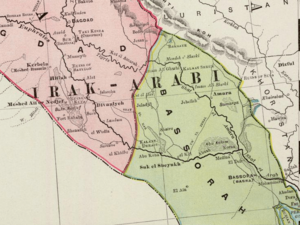
The Iraqi government said that Kuwait had always been part of Iraq. They claimed Kuwait only became a separate country because the British government interfered. After a 1913 agreement, Britain planned to make Kuwait a separate area. But this plan was never fully put into action. Iraq also said that Kuwait's leader, the Emir, was not popular. Iraq claimed it was helping Kuwaitis gain more freedom by overthrowing him.
Kuwait was loosely under the rule of Basra, a region of the Ottoman Empire. Its ruling family, the Al Sabah family, made a deal with Britain in 1899. This deal gave Britain control over Kuwait's foreign affairs. But Kuwait did not try to leave the Ottoman Empire. Because of this, its borders with Basra were never clearly set.
Talks with the United States
On July 25, 1990, April Glaspie, the U.S. ambassador to Iraq, asked Iraq why it was moving troops near the border. The ambassador told Iraq that the U.S. had "no opinion" on conflicts between Arab countries. She also said the U.S. did not want "to start an economic war against Iraq."
These statements might have made Saddam Hussein believe the U.S. would not stop him from invading Kuwait. Saddam and Glaspie later disagreed about what was said. A week before the invasion, a U.S. official told Congress that the U.S. had no treaty to defend Kuwait. Some believe the U.S. thought Saddam only wanted to pressure Kuwait, not fully invade it.
The Invasion Begins
On August 2, 1990, at 2:00 AM, Iraq launched its invasion of Kuwait. Four special Iraqi army divisions and special forces attacked. Helicopters and boats carried commandos to attack Kuwait City. Other divisions took over airports and airbases. Iraqi helicopters and fighter jets supported the ground troops. Their main goal was to control the sky and bomb targets in Kuwait City.
Kuwait was not ready for the attack, even though Iraq had been threatening for months. Kuwaiti forces fought back, but they were greatly outnumbered. Kuwaiti tanks and artillery fought delaying battles near Al Jahra. In the south, some Kuwaiti forces quickly moved to Saudi Arabia. Only two small Kuwaiti missile boats escaped.
About 20% of Kuwait's air force planes were lost or captured. Kuwaiti planes fought Iraqi helicopters over Kuwait City. They caused heavy losses to the Iraqi troops. The remaining 80% of Kuwaiti planes flew to Saudi Arabia and Bahrain. Some even took off from highways because the runways were taken over.
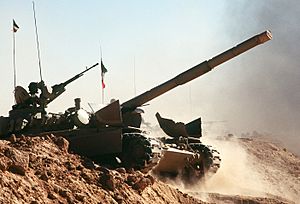
Iraqi troops attacked Dasman Palace, the royal home. Kuwaiti guards and tanks fought hard, but the palace fell after Iraqi marines landed. The Kuwaiti Emir, Jaber Al-Ahmad Al-Jaber Al-Sabah, had already fled to Saudi Arabia. His half-brother, Sheikh Fahad Al-Ahmed Al-Jaber Al-Sabah, was killed defending the palace.
By the end of the first day, only small groups of Kuwaiti fighters were left. By August 3, most Kuwaiti military units were forced to retreat or were defeated. Ali al-Salem Air Base was the last base still fighting. Kuwaiti planes flew supplies from Saudi Arabia to help. But by nightfall, Iraqi forces had taken over the base. Soon, all Kuwaiti military units had to retreat or were captured.
Kuwaiti Resistance Movement
After Iraq took over, Kuwaitis started a local armed resistance movement. Most Kuwaitis arrested, tortured, or killed during the occupation were regular people. The resistance had many more casualties than the military forces helping Kuwait. These resistance fighters were mostly ordinary citizens with no special training.
At first, Iraqi forces were not very violent. They told Kuwaitis to change their license plates to Iraqi ones. They also set up many checkpoints. But within weeks, Kuwaitis began to resist peacefully. People stayed home from work and school. They also printed information pamphlets at home and shared them. After this, the Iraqi military became much harsher.
About 400,000 Kuwaiti citizens left the country. For those who stayed and joined the resistance, a network of safe houses was created. They printed anti-war messages and provided hiding places and fake IDs for Kuwaitis wanted by the Iraqi secret police. Resistance groups held secret meetings in mosques.
Kuwaiti women, like Asrar al-Qabandi, were important resistance leaders. She helped people escape, smuggled weapons and money, cared for the wounded, and destroyed Iraqi spy devices. She was captured and killed in January 1991. Other women held street protests with signs saying "Free Kuwait." Iraqi police searched homes of those suspected of helping foreigners or smuggling money to the resistance. Money smuggled to the resistance was often used to bribe Iraqi soldiers. The resistance also used car bombs and sniper attacks, causing many Iraqi casualties.
By August 1990, the U.S. government began supporting the resistance with information and other secret help. Both the CIA and U.S. Green Berets were involved. President Bush said he supported the Kuwaiti underground. The U.S.-led military operation, Desert Storm, also helped the resistance from its base in Saudi Arabia.
The Kuwaiti government went into exile in Saudi Arabia and supported the resistance from there. Even though Iraq tried to stop all communication, the resistance smuggled satellite phones across the border. This allowed them to talk to their government in exile. Kuwaitis also printed secret newspapers and pamphlets. These were important because Iraq controlled all news. People from all parts of Kuwaiti society joined the resistance, breaking down old social barriers. An army officer said, "In Kuwait, everyone from children to old men resisted."
Why the Resistance Was Important
The resistance movement helped show that Iraq's invasion was not about helping a popular uprising. It also protected Americans, Britons, and other foreigners stuck in Kuwait. Some believe the resistance helped create a stronger society in Kuwait after the occupation.
At the Al Qurain Martyrs Museum, Kuwait remembers its citizens killed during the resistance. The families of these heroes received benefits from the Kuwaiti government. Kuwait wants to show that its citizens played a big part in freeing their own country, not just the U.S.-led forces.
Aftermath of the Invasion
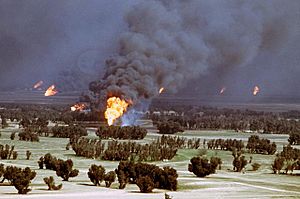
After Iraq won the invasion, Saddam Hussein put a new leader in charge of Kuwait. The exiled Kuwaiti royal family and former government officials started an international effort. They wanted other countries to pressure Iraq to leave Kuwait. The UN Security Council passed 12 resolutions demanding Iraq leave, but Iraq did not listen.
About half of Kuwait's population, including 400,000 Kuwaitis, fled the country. India helped evacuate over 170,000 of its citizens by flying almost 488 flights over 59 days. A study in 2005 showed that the Iraqi occupation had a lasting negative effect on the health of Kuwaiti people.
International Response and the Gulf War
All major world powers strongly condemned Iraq's invasion. Even countries that were usually friends with Iraq, like France and India, demanded Iraq leave Kuwait. Many countries, including the Soviet Union and China, stopped selling weapons to Iraq. By late 1990, the United States told Iraq to leave Kuwait by January 15, 1991, or face war.
On August 3, 1990, the UN Security Council passed Resolution 660. This resolution condemned the invasion and demanded Iraq immediately withdraw its forces.
After talks failed, the United States-led coalition launched a huge military attack on Iraq in mid-January 1991. By January 16, Allied planes were bombing Iraqi military sites. The Iraqi Air Force was destroyed. Fighting continued until late February. On February 25, Kuwait was officially freed from Iraq. On March 15, 1991, the Emir of Kuwait returned after more than 8 months away. During the occupation, about 1,000 Kuwaiti civilians were killed. More than 300,000 residents fled.
After the Gulf War
In December 2002, Saddam Hussein apologized for the invasion. This was shortly before he was removed from power in 2003. Two years later, the Palestinian leadership also apologized for supporting Saddam during the war. Yemen's president, Ali Abdullah Saleh, who was an ally of Saddam, also backed the invasion. After Iraq lost the Gulf War, many Yemenis were sent away from Kuwait by the restored government.
The U.S. military still has a strong presence in Kuwait. In February 2015 alone, 4,000 more troops were added. There is also a large U.S. civilian presence. About 18,000 American children in Kuwait are taught by 625 U.S. teachers.
See also
 In Spanish: Invasión de Kuwait para niños
In Spanish: Invasión de Kuwait para niños
- Operation Desert Storm
- Airlift — A Bollywood film based on the Indian evacuation right after the invasion.
- United Nations Security Council Resolution 660
- Persian Gulf war rationale
- Nayirah testimony


